Abstract
The removal of acidic gases and impurities from gas mixtures is a critical operation in the oil and gas industry. Several separation techniques, e.g., cryogenic fractionation, polymeric membranes, zeolites, and metal–organic frameworks, are employed to treat gas mixtures depending upon the nature of separation and contaminants present in the gas mixtures. However, removing N2, H2, H2S, and CO2 contents from industrial gas mixtures is a challenging step due to economic factors, high energy consumption, and effective separation. Hydrate-based separation for selective gas removal is a promising and efficient separation technique over a range of temperatures, pressures, and acidic gas contents. The enclathration of CO2, H2, N2, H2S, and other natural gas constituents effectively removes acidic gases and other contaminants from process gas streams. This work presents a novel process design to remove acidic gases and other contaminants from industrial waste gases and natural gas mixtures to achieve the desired selectivity in gas mixtures. Multi-phase equilibria calculations were also performed for various binary and ternary gas mixtures (e.g., CO2 + CH4, H2S + CH4, CO2 + N2, CH4 + CO2 + H2S, and CO2 + H2S + N2) over a range of compositions and T, P conditions. The former calculations established the suitable region in terms of temperature and pressure for adequate separations. To determine the optimal process conditions (T & P) for efficient separation, fractional cage occupancy and gas mole fraction in each phase were also computed. A detailed analysis of the hydrate-based separation shows that the number of stages necessary for desired separation efficiency depends on the nature of the gas mixture and hydrate stability.
1. Introduction
Gas hydrate formation offers versatile applications, including seawater desalination, CO2 sequestration, hydrogen storage, natural gas transportation, and separation of gases from power plants or other chemical plants [1,2,3,4,5,6,7]. With increasing global warming and climate change, it is necessary to capture and sequester greenhouse gases (CH4, CO2) from flue gas mixtures. Existing processes for separation of CH4 and CO2 from a gas mixture are not efficient and economical and thus create a major roadblock in the sequestration of these greenhouse gases [8,9,10,11,12,13,14]. Depending on the composition of the gas mixture and the desired separation efficiency, different techniques can be employed to separate the mixture components. Examples of commonly used separation techniques include cryogenic distillation, polymer membranes, and adsorption and absorption-based processes [15,16,17]. High energy consumption, inefficient separation, and other economic factors limit the application of these separation techniques. Due to this, new energy-efficient separation processes (such as zeolites and metal–organic frameworks (MOFs)) are being aggressively researched. Gas separation using clathrate hydrates offers an attractive alternative with its selective separation and high efficiency compared to other available separation techniques. Unlike zeolite and MOFs, where different types of structures are needed for different gas mixtures, a wide variety of gas mixtures can be handled using the hydrate-based process. Only temperature and pressure conditions need to be optimized depending on which component is getting enclathrated. The high concentration of gases stored in hydrate cages and the ability to tune cage occupancy by simply changing temperature or pressure provides a novel method for gas separation [8,18,19,20,21,22,23,24].
Separating components of a gas mixture by forming clathrate hydrates has been attempted by many researchers [1,3,7,21,22,23]. Figure 1 presents a pictorial representation and explains the fundamental concept behind hydrate-based separation. In Figure 1, a two-component gas mixture is separated by bringing the gas mixture in contact with water and subjecting the gas mixture plus water to hydrate formation and dissociation steps. In the hydrate formation step, T & P conditions are chosen such that HF-2 (a component that forms hydrate at lower pressure compared to HF-1) preferentially enters the solid hydrate phase. The gas phase (now richer in HF-1) is easily separated from the solid hydrate phase. The solid hydrate phase is then subjected to a hydrate dissociation step (increasing T and reducing P) such that the solid hydrate is dissociated forming a liquid water phase and a gas phase comprising only of HF-2. In a real application, it is possible that both components will go into the hydrate phase. However, concentration of different components will be different in gas vs. hydrate phase thus enabling separation in each step. In such cases, multiple hydrate formation and dissociation stages may be required to achieve the desired separation. Therefore, the careful selection of temperature and pressure for each step is essential to reduce the number of stages for optimal process design. In this work, process design calculations were performed for various binary and ternary gas mixtures (e.g., CO2 + N2, CH4 + CO2, CH4 + H2S, CH4 + H2S + CO2, and N2 + H2S + CO2 systems) over a range of feed compositions. In addition, the current work critically investigates the effectiveness of a hydrate-based gas separation process.
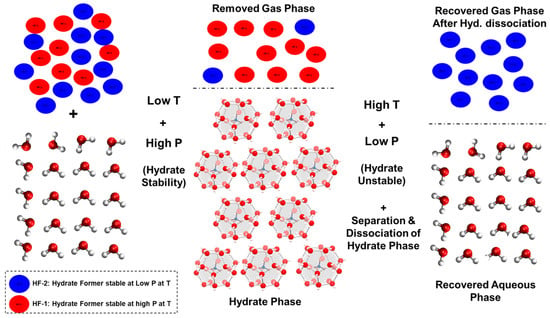
Figure 1.
Pictorial representation of hydrate-based gas separation.
2. Theory
The hydrate phase equilibria for gas separation were calculated using the van der Waals and Platteeuw (vdWP) model coupled with the Gibbs energy minimization (GEM) algorithm. The coupled vdWP and GEM approach is a comprehensive gas hydrate thermodynamic model based on a strictly statistical thermodynamic approach that can accurately predict hydrate phase equilibria [25]. For each component, equality of fugacity in all the phases (Equation (1)) is considered as the necessary and fundamental condition for hydrate phase stability [26,27,28].
The superscript H exemplifies the hydrate phase which can be s-I, s-II, or s-H; however, the superscript () describes the liquid, vapor, and ice phases. The Helgeson [29,30] equation (Equation (2)) is used to calculate the fugacity of water in the hydrate phase.
where:
- fugacity of water in any phase k
- fugacity of water at standard conditions (To = 298.15 K and P = 1 bar)
- chemical potential of water in any phase k
- Gibbs free energy of water at standard conditions (To = 298.15 K and P = 1 bar)
- Gas constant.
The simplified algorithm has been shown in Figure 2 and a detailed procedure for phase equilibria calculations was discussed by Ballard and Sloan [30,31,32,33,34].
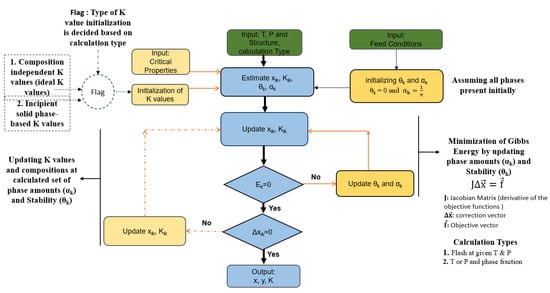
Figure 2.
Gibbs free energy minimization (GEM) algorithm. Reproduced with permission from ref. [28]. 2021 Elsevier Science and Technology Journal.
3. Results and Discussions
The following section presents phase equilibria calculation results and process design for separation of different gas mixtures.
3.1. Process Design for CH4 + H2S Mixture
Figure 3 shows the CH4 + H2S hydrate phase equilibria predicted using the vdWP and GEM model over a range of temperatures and compositions. It can be observed that H2S forms hydrate at much milder conditions (lower P/higher T) compared to CH4. At the same temperature, with increasing H2S concentration in the mixture, the pressure required to form hydrate decreases, i.e., hydrate phase boundary shifts to a lower pressure. Due to this significant difference in the CH4 vs. H2S hydrate stability region, their mixture can be easily separated.
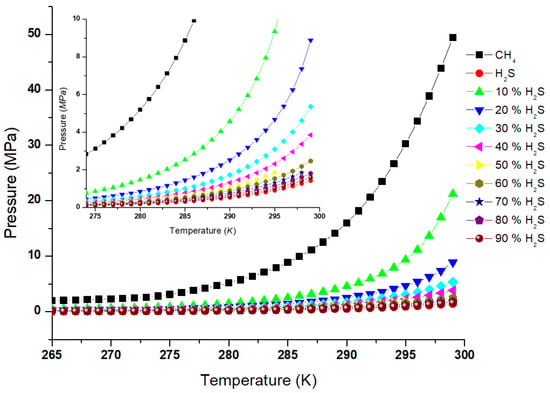
Figure 3.
Hydrate phase equilibria predictions for CH4+H2S mixture over a range of temperatures. Inset shows the expanded view. Reproduced with permission from ref. [9]. 2015 M.N. Khan, Ph.D. Thesis.
Figure 4 shows predicted composition in the hydrate phase for different concentrations of H2S in the CH4 + H2S gas mixture. For the case of 70:30 H2S:CH4, there is very clear separation with the hydrate phase almost entirely comprising H2S (recoveries calculated in Figure S2). A similar conclusion was observed for other binary gas mixtures with the appropriate P and T conditions selection. Separation becomes challenging at higher CH4 concentrations, as both gases compete for enclathration. This concept was applied for an industrially relevant composition (Bab Field, UAE—~70 mol.% CH4 + 30 mol.% H2S), and the process design for separating such a gas mixture is shown in Figure 5.

Figure 4.
Predicted hydrate phase composition for CH4 + H2S mixture for a range of H2S concentrations. Reproduced with permission from ref. [9]. 2015 M.N. Khan, Ph.D. Thesis.
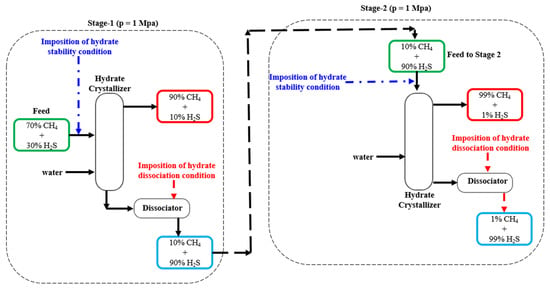
Figure 5.
Separation process scheme for a gas composition from the Bab Field, UAE (~70 mol.% CH4 + 30 mol.% H2S). Reproduced with permission from ref. [9]. 2015 M.N. Khan, Ph.D. Thesis.
Figure 5 reveals the process design calculation for 70 mol.% CH4 + 30 mol.% H2S gas mixture in a hydrate crystallizer and dissociator (two-column). The effluent from Stage 1 upon hydrate dissociation results in a gas stream with 90/10% (H2S/CH4) mole fraction. The product stream from Stage 1 is then subjected to the second hydrate crystallization stage, which results in a gas stream that is 99% CH4. Gas produced after the decomposition of hydrate formed in the second stage is 99% H2S. The calculations of fractional cage occupancies (Figure 6) and mole fraction establish the optimal process condition to achieve the desired separation. The calculated recovery and separation factors for gas mixtures depends on the feed composition and T & P conditions. In addition, thermodynamic calculation shows that the appropriate selection of specific T, P conditions can provide clear and efficient separation. Novel process designs were also developed for other gas mixtures. The number of stages needed for desired separation efficiency was assessed and was found to be strongly dependent on the process T & P and hydrate stability region. Recovery and selectivity for gaseous mixtures were significantly dependent on the hydrate former polarity and process conditions.
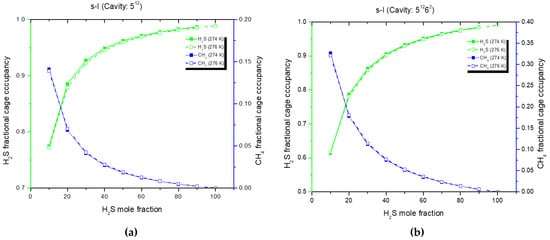
Figure 6.
Fractional cage occupancy of hydrate formers in CH4 + H2S binary gas mixture (a) Small Cavity and (b) Large Cavity at 1 MPa.
3.2. Process Design for CH4 + CO2 Mixture
Predicted hydrate phase boundaries for CH4 and CO2 mixture are shown in Figure 7. CH4 + CO2 hydrate phase equilibria is rather complex and increasing CO2 concentration has different effects at different T/P. CO2 hydrate is more stable at lower pressures at given temperature than CH4 hydrate, and with CO2 liquification (at higher temperatures and pressures), CH4 is relatively stable.
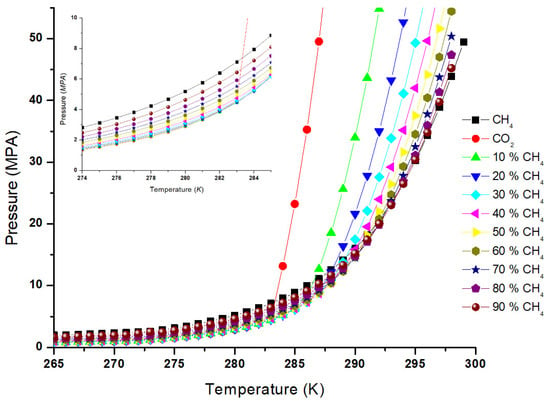
Figure 7.
Predicted hydrate phase equilibria for CH4 + CO2 mixture. Inset shows expanded view. Reproduced with permission from ref. [9]. 2015 M.N. Khan, Ph.D. Thesis.
Figure 8 presents the changes in fractional cage occupancies of CO2 and CH4 in the small (512) and large cavities (51262) as a function of CO2 mole fraction at 10 MPa at 274 K and 276 K, respectively. The variation in fractional cage occupancy demonstrates the selectivity of CO2 vs. CH4 in each cavity as a function of the CO2 mole fraction.

Figure 8.
Fractional cage occupancy of hydrate formers in CO2 + CH4 binary gas mixture for (a) Small Cavity and (b) Large Cavity at 10 MPa.
Figure 9 shows the gas separation process design for CH4 + CO2 mixture, where the feed gas stream was subjected to hydrate stability conditions followed by dissociation. Due to the complexity in the hydrate phase diagram for this mixture, eight stages were required to achieve a stream comprising 99 mol% CO2. Rigorous GEM calculations (Figure 10) coupled with mass balance for CH4 + CO2 binary systems over a CH4/CO2 concentration range also reveal the necessity of multiple stages for CO2 separation from CH4.
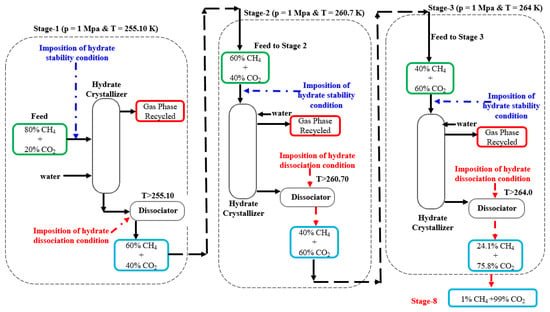
Figure 9.
Process design for CO2 + CH4 separation. Reproduced with permission from ref. [9]. 2015 M.N. Khan, Ph.D. Thesis.
Additionally, a detailed investigation of the separation stage’s dependency on process conditions leads to selecting optimum process conditions to achieve desired separation. Behzad et al. (2019) [35] conducted the experimental investigation to identify the impact of pressure on the separation of CH4 from CH4 + CO2 gas mixtures. However, their experimental studies on various gas mixture compositions (CH4/CO2) with multiple system pressures clearly indicate that there is a non-linear dependency of system pressure to the separation factor. Nevertheless, it was concluded that, in addition to the process parameters (T, P, feed composition), retention time, molecular size, and the presence of promotors (e.g., THF, CP) play an important role in deciding the overall selective separation of the components [35,36]. In addition, the nonlinear dependency may be attributed to the large errors in liquid flow rate and the compositional data collected. A detailed experimental study on the kinetics of CH4 + CO2 systems with the simultaneous measurements of compositional data along with fractional cage occupancy measurements may give further insight about the effectiveness of the separation in real time. In addition, a systemic study to analyze the Xe recovery from natural gas in multiple gas hydrate separation was also conducted by Sergeeva et al. (2020) [37]. The efficient recovery of Xe from natural gas mixtures and the number of stages required is dictated by the stability pressure of HF (hydrate former) and is consistent with the current work’s conclusion. Figure 11 shows the effect of the process T and P on the number of stages needed for CH4/CO2 separation. At low and medium pressures (5–10 MPa), both CH4 and CO2 compete for enclathration, which makes it difficult to separate these two gases (pinch point). However, at a high pressure of 80 MPa, one stage is all that is needed for efficient separation.
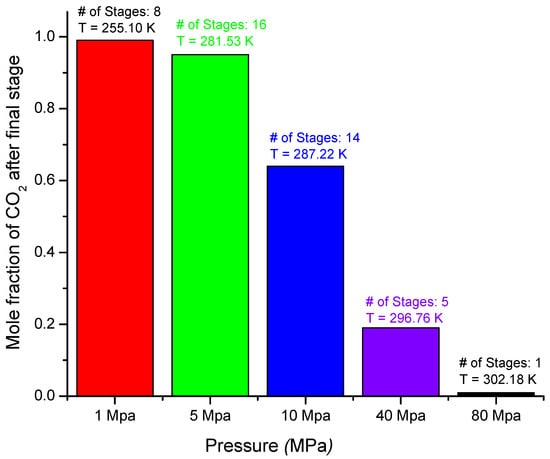
Figure 11.
Effect of T, P on the number of separation stages for 80/20 CH4/CO2 gas mixture. Reproduced with permission from ref. [9]. 2015 M.N. Khan, Ph.D. Thesis.
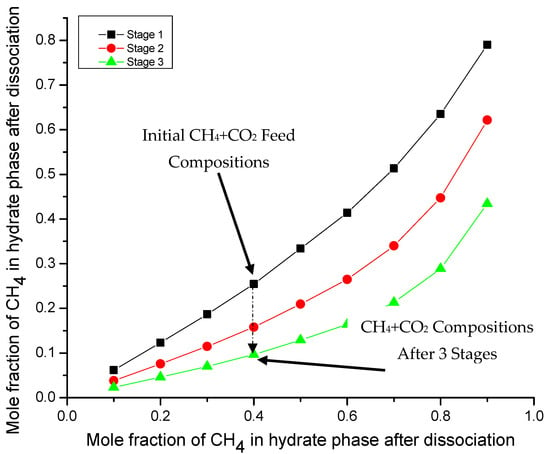
Figure 10.
The relationship between mole fraction of CH4 after dissociation from hydrate phase as a function of feed phase mole fraction for CH4 + CO2 binary system.
3.3. Process Design for N2 + CO2 Mixture
To further exhibit the effectiveness of CO2 capture from the CO2 + N2 gas mixture, the phase equilibria calculations were conducted over a range of CO2 concentrations. The phase equilibria calculations illustrate the range of temperature and pressure conditions over which desired separation can be achieved. Figure 12 shows the hydrate phase equilibria for the CO2 + N2 mixture. Increasing N2 concentration causes the hydrate phase boundary to shift to a higher pressure and lower temperature.
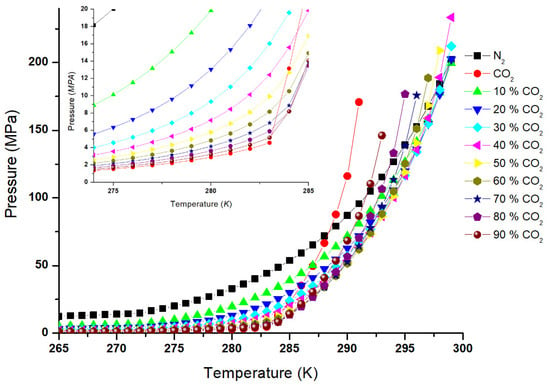
Figure 12.
Predicted hydrate phase equilibria for N2 + CO2 mixture. Inset shows the expanded view. Reproduced with permission from ref. [9]. 2015 M.N. Khan, Ph.D. Thesis.
Fractional cage occupancies of CO2 and N2 in the small and large cage are shown in Figure 13. It can be observed that the N2 cage occupancy in the small (512) and large (51262/51264) cavities decreases with increasing CO2 content. The decrease in N2 cage occupancy with the increase in temperature is associated with the decrease in the Langmuir constant.
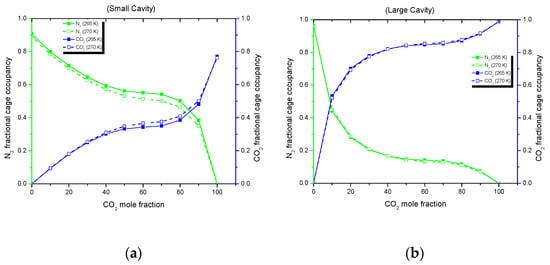
Figure 13.
Fractional cage occupancy of hydrate formers in CO2 + N2 binary gas mixture for (a) Small Cavity and (b) Large Cavity at 15 MPa.
Figure 14 shows the process design diagrams for N2 + CO2 mixture. Upon subsequent hydrate formation and dissociation, 99 mol% of CO2 can be removed with a total of at least two stages from the feed stream at 1 MPa.
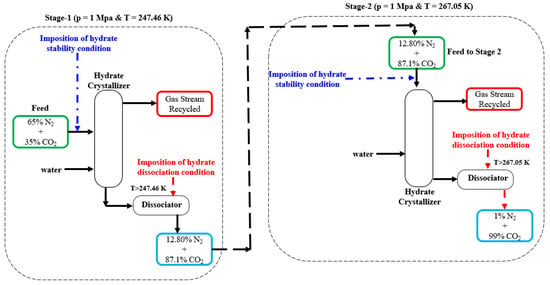
Figure 14.
Process design for CO2 + N2 separation. Reproduced with permission from ref. [9]. 2015 M.N. Khan, Ph.D. Thesis.
Figure 15 illustrates the effect of process T and P on the number of separation stages needed for N2/CO2 separation. The calculations reveal that, for CO2 + N2 separation, two stages are sufficient to have the desired separation, even at lower pressures (<1 MPa), as N2 is a high-pressure hydrate former. However, at high pressures, N2 and CO2 show comparable fractional cage occupancies in small and large cages, which may lead to a pinch point.
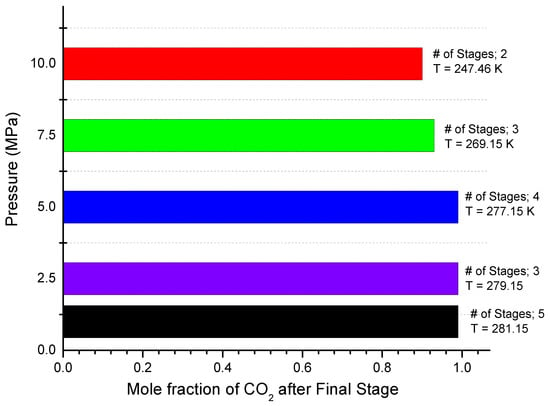
Figure 15.
Effect of process T and P on the number of separation stages for N2/CO2 (65/35 mol.%). Reproduced with permission from ref. [9]. 2015 M.N. Khan, Ph.D. Thesis.
Moreover, it can be observed from Figure 16 that, for N2 + CO2 binary systems, a minimum of at least three stages are necessary for the clear and efficient removal of N2 from the binary gas mixture. With increasing CO2 concentration in the feed gas, nitrogen molecules were replaced by CO2 in the hydrate phase, which is relatively more stable at critical process conditions.
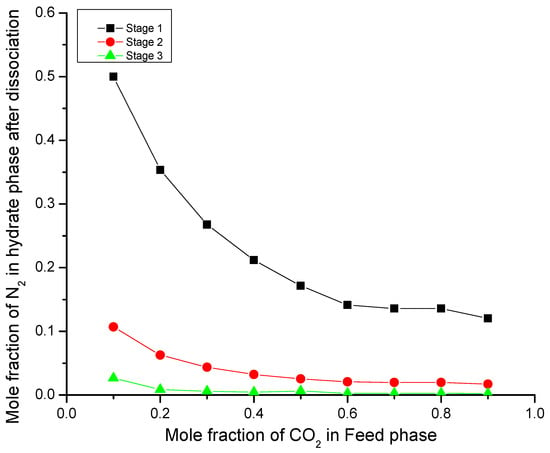
Figure 16.
The relationship between mole fraction of N2 after dissociation from hydrate phase as a function of CO2 feed phase mole fraction for N2 + CO2 mixture.
3.4. Ternary Gas Mixture
A similar methodology was employed for ternary gas mixtures to further check the effectiveness of hydrate-based gas separation. The Gibbs energy minimization calculations were conducted for CH4 + H2S + CO2 gas mixtures over a range of xH2S/xCO2 ratios, as shown in Figure 17a–d. It is evident from Figure 17 that the percentage of H2S recovered after hydrate dissociation increases over consecutive stage operations. A clear hydrate-based separation was achieved over a range of CH4 mole fractions for various xH2S/xCO2 ratios.
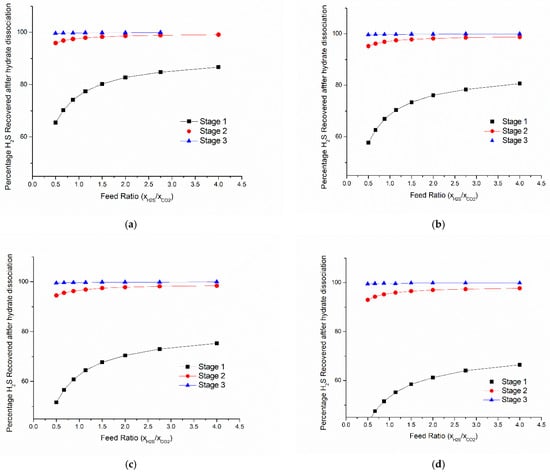
Figure 17.
Effect of feed ratio (xH2S/xCO2) on percentage of H2S recovered after hydrate dissociation: (a) 70 mol.% CH4 in feed, (b) 80 mol.% CH4 in feed, (c) 85% mol.% CH4 in feed (d) 90 mol.% CH4 in the feed.
Phase equilibria calculations were also carried out for ternary gas mixtures (Figure 18; 84.2% N2 + 0.05% H2S + 15.7% CO2). Multiple stages are necessary to capture H2S from the ternary gas mixture. A detailed analysis of the hydrate-based separation shows that the number of stages required to attain the desired separation efficiency depends on the nature of the gas mixture and on hydrate stability.
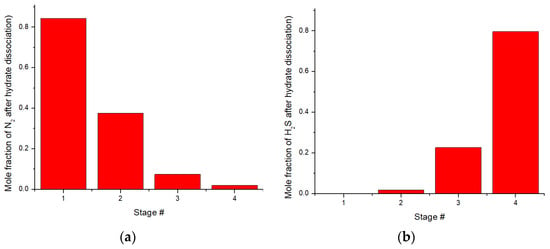
Figure 18.
The enclathration of (a) change in N2 mole fraction for subsequent stages and (b) change in H2S mole fraction for subsequent stagesfrom ternary gas mixture as a function of separation stage #.
In addition, calculations were performed for multiple other ternary gas mixture compositions (for N2 + H2S+ CO2 ternary systems), and the decrease in mole fraction of nitrogen for each stage is presented in Figure S1 (Supplementary Materials).
4. Conclusions
A clathrate hydrate-based process has been presented for separating different components of industrial waste gas mixtures. The fundamental principle behind this separation is the thermodynamics of the formation of the hydrate phase by different molecules. Hydrate phase equilibria for various binary and ternary gas mixtures were computed to determine the feasibility of hydrate-based gas separation. The fractional cage occupancies and component mole fraction were also estimated to determine optimum process parameters to achieve the desired separation. Process designs have also been proposed for separation of some industrially relevant gas mixtures, including CH4 + CO2, N2 + CO2, CH4 + H2S, CH4 + H2S + CO2, and N2 + H2S + CO2 mixtures. Recovery and selectivity for gaseous mixtures were significantly dependent on the hydrate former polarity and process conditions.
Supplementary Materials
The following are available online at https://www.mdpi.com/article/10.3390/en15030966/s1. Table S1. Phase Stability criteria for GEM algorithm. Figure S1. Case study for hydrate-based Separation for the ternary gas mixture of CO2 + N2 + H2S (Feed: 86.36 mol % N2 + 4.54 mol % CO2 + 9.09 mol % H2S). Figure S2. Predicted Recoveries of CH4 and H2S in binary hydrate systems for a range of H2S concentrations.
Author Contributions
M.K.: conceptualization, calculations, results analysis, and writing draft. P.W.: conceptualization, results analysis, and review. C.P.: funding acquisition, review, and editing. C.K.: funding acquisition, review, and editing. All authors have read and agreed to the published version of the manuscript.
Funding
The authors acknowledge the Petroleum Institute Research Center (PIRC) grant “Advanced PVT-Properties and Molecular Modeling of Complex Fluids in Support of Safe and Green Hydrocarbon Production” (project code: LTR14009). The authors also acknowledges the current and past consortium member at Centre of Hydrate Research at Colorado School of Mines.
Institutional Review Board Statement
Not applicable.
Informed Consent Statement
Not applicable.
Data Availability Statement
All data presented and analyzed in this work are included in the manuscript.
Acknowledgments
The authors acknowledge CHR consortium members for their support.
Conflicts of Interest
The authors declare no conflict of interest.
References
- Linga, P.; Kumar, R.; Lee, J.D.; Ripmeester, J.; Englezos, P. A new apparatus to enhance the rate of gas hydrate formation: Application to capture of carbon dioxide. Int. J. Greenh. Gas Control 2010, 4, 630–637. [Google Scholar] [CrossRef]
- Matsuda, S.; Tsuda, H.; Mori, Y.H. Hydrate formation using water spraying onto a cooled solid surface in a guest gas. AIChE J. 2006, 52, 2978–2987. [Google Scholar] [CrossRef]
- Chatti, I.; Delahaye, A.; Fournaison, L.; Petitet, J.P. Benefits and drawbacks of clathrate hydrates: A review of their areas of interest. Energy Convers. Manag. 2005, 46, 1333–1343. [Google Scholar] [CrossRef]
- Gudmundsson, J.S.; Andersson, V.; Levik, O.I.; Mork, M. Hydrate Technology for Capturing Stranded Gas. Ann. N. Y. Acad. Sci. 2000, 912, 403–410. [Google Scholar] [CrossRef]
- Englezos, P. Clathrate hydrates. Ind. Eng. Chem. Res. 2002, 32, 1251–1274. [Google Scholar] [CrossRef]
- Makogon, I. Hydrates of Natural Gas; PennwWell Books: Tulsa, OK, USA, 1981. [Google Scholar]
- Thomas, S.; Dawe, R.A. Review of ways to transport natural gas energy from countries which do not need the gas for domestic use. Energy 2003, 28, 1461–1477. [Google Scholar] [CrossRef]
- Adeyemo, A.; Kumar, R.; Linga, P.; Ripmeester, J.; Englezos, P. Capture of carbon dioxide from flue or fuel gas mixtures by clathrate crystallization in a silica gel column. Int. J. Greenh. Gas Control 2010, 4, 478–485. [Google Scholar] [CrossRef]
- Khan, M. Phase Equilibria Modeling of Inhibited Gas Hydrate Systems Including Salts: Applications in Flow Assurance, Seawater Desalination and Gas Separation; Colorado School of Mines: Golden, CO, USA, 2016. [Google Scholar]
- Trautz, R.; Swisher, J.; Chiaramonte, L.; Hollis, R.; Perron, J.; Pronske, K.; Myhre, R.; Stone, M.; Saini, D.; Jordan, P.; et al. California CO2 Storage Assurance Facility Enterprise (C2SAFE): Final Technical Report; Pittsburgh, PA, USA; Morganrown, WV, USA, 2018. [Google Scholar] [CrossRef]
- Bergerson, J.A.; Lave, L.B. Baseload coal investment decisions under uncertain carbon legislation. Environ. Sci. Technol. 2007, 41, 3431–3436. [Google Scholar] [CrossRef] [PubMed][Green Version]
- U.S. Energy Administration, Office of Integratedand International Energy Analysis. Annual Energy Outlook 2013 with Projections to 2040; 2013. [CrossRef]
- Carbon Capture and Storage: An Effective Way to Mitigate Global Warming on JSTOR. Available online: https://www.jstor.org/stable/24098511 (accessed on 29 September 2021).
- Abbasi, T.; Tauseef, S.M.; Abbasi, S.A. Anaerobic digestion for global warming control and energy generation—An overview. Renew. Sustain. Energy Rev. 2012, 16, 3228–3242. [Google Scholar] [CrossRef]
- Yu, C.-H.; Huang, C.-H.; Tan, C.-S. A Review of CO2 Capture by Absorption and Adsorption. Aerosol Air Qual. Res. 2012, 12, 745–769. [Google Scholar] [CrossRef]
- Lott, D.E. Improvements in noble gas separation methodology: A nude cryogenic trap. Geochem. Geophys. Geosystems 2001, 2, 2001GC000202. [Google Scholar] [CrossRef]
- Bernardo, P.; Drioli, E.; Golemme, G. Membrane Gas Separation: A Review/State of the Art. Ind. Eng. Chem. Res. 2009, 48, 4638–4663. [Google Scholar] [CrossRef]
- Kang, S.-P.; Lee, H.L. Recovery of CO2 from Flue Gas Using Gas Hydrate: Thermodynamic Verification through Phase Equilibrium Measurements. Environ. Sci. Technol. 2000, 34, 4397–4400. [Google Scholar] [CrossRef]
- Aaron, D. Separation of CO2 from Flue Gas: A Review. Taylor Fr. 2005, 40, 321–348. [Google Scholar] [CrossRef]
- Klara, S.M.; Srivastava, R.D. U.S. DOE integrated collaborative technology development program for CO2 separation and capture. Environ. Prog. 2002, 21, 247–253. [Google Scholar] [CrossRef]
- Linga, P.; Kumar, R.; Englezos, P. Gas hydrate formation from hydrogen/carbon dioxide and nitrogen/carbon dioxide gas mixtures. Chem. Eng. Sci. 2007, 62, 4268–4276. [Google Scholar] [CrossRef]
- Linga, P.; Kumar, R.; Englezos, P. The clathrate hydrate process for post and pre-combustion capture of carbon dioxide. J. Hazard. Mater. 2007, 149, 625–629. [Google Scholar] [CrossRef]
- Linga, P. Separation of Carbon Dioxide from Flue Gas (Post-Combustion Capture) via Gas Hydrate Crystallization. Ph.D. Thesis, University of British Columbia, Vancouver, BC, Canada, 2009. [Google Scholar] [CrossRef]
- Azari, A.; Atashrouz, S.; Mirshekar, H.; González, A.; Okumura, K.; Ten Elshof, J.E. Prediction the Vapor-Liquid Equilibria of CO2-Containing Binary Refrigerant Mixtures Using Artificial Neural Networks. ISRN Chem. Eng. 2013, 2013, 930484. [Google Scholar] [CrossRef]
- Platteeuw, J.C.; van der Waals, J.H. Thermodynamic properties of gas hydrates. Mol. Phys. 1958, 1, 91–96. [Google Scholar] [CrossRef]
- Ward, Z.T. Phase Equilibria of Gas Hydrates Containing Hydrogen Sulfide and Carbon Dioxide; Colorado School of Mines: Golden, CO, USA, 2015. [Google Scholar]
- Khan, M.N.; Warrier, P.; Peters, C.J.; Koh, C.A. Advancements in hydrate phase equilibria and modeling of gas hydrates systems. Fluid Phase Equilib. 2018, 463, 48–61. [Google Scholar] [CrossRef]
- Khan, M.N.; Warrier, P.; Creek, J.L.; Peters, C.J.; Koh, C.A. Vapour-liquid equilibria (VLE) and gas hydrate phase equilibria predictions using the cubic-plus association equation of state: CSMGem extension to association EoS model. J. Nat. Gas Sci. Eng. 2021, 94, 104083. [Google Scholar] [CrossRef]
- Shock, E.L.; Helgeson, H.C. Calculation of the thermodynamic and transport properties of aqueous species at high pressures and temperatures: Standard partial molal properties of organic species. Geochim. Cosmochim. Acta 1990, 54, 915–945. [Google Scholar] [CrossRef]
- Ballard, A.L. Non-Ideal Hydrate Solid Solution Model for a Multi-Phase Equilibria Program, A. Doctoral Dissertation, Colorado School of Mines, Golden, CO, USA, 2002. [Google Scholar]
- Sloan, E.D., Jr.; Koh, C.A. Clathrate Hydrates of Natural Gases; CRC Press: Golden, CO, USA, 2007. [Google Scholar]
- Ballard, A.L.; Sloan, E.D. The next generation of hydrate prediction: Part III. Gibbs energy minimization formalism. Fluid Phase Equilib. 2004, 218, 15–31. [Google Scholar] [CrossRef]
- Jager, M.D.; Ballard, A.L.; Sloan, E.D. The next generation of hydrate prediction: II. Dedicated aqueous phase fugacity model for hydrate prediction. Fluid Phase Equilib. 2003, 211, 85–107. [Google Scholar] [CrossRef]
- Ballard, A.L.; Sloan, J.D. The Next Generation of Hydrate Prediction: An Overview. J. Supramol. Chem. 2002, 2, 385–392. [Google Scholar] [CrossRef]
- Partoon, B.; Sabil, K.M.; Lau, K.K.; Nasrifar, K.; Shariff, A.M. Selective Separation of Methane from Carbon Dioxide through sII Hydrates Formation in a Semibatch Process. Ind. Eng. Chem. Res. 2019, 58, 16834–16842. [Google Scholar] [CrossRef]
- Partoon, B.; Sabil, K.M.; Lau, K.K.; Lal, B.; Nasrifar, K. Production of gas hydrate in a semi-batch spray reactor process as a means for separation of carbon dioxide from methane. Chem. Eng. Res. Des. 2018, 138, 168–175. [Google Scholar] [CrossRef]
- Sergeeva, M.; Petukhov, A.; Shablykin, D.; Trubyanov, M.; Atlaskin, A.; Malyshev, V.; Vorotyntsev, V. Xenon recovery from natural gas by multiple gas hydrate crystallization: A theory and simulation. Sep. Sci. Technol. 2020, 55, 144–154. [Google Scholar] [CrossRef]
Publisher’s Note: MDPI stays neutral with regard to jurisdictional claims in published maps and institutional affiliations. |
© 2022 by the authors. Licensee MDPI, Basel, Switzerland. This article is an open access article distributed under the terms and conditions of the Creative Commons Attribution (CC BY) license (https://creativecommons.org/licenses/by/4.0/).